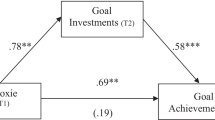Abstract
Although people generally endorse intrinsic goals for growth, intimacy, and community more than extrinsic goals for money, appearance, and popularity, people sometimes over-emphasize extrinsic goals, to the potential detriment of their well-being. When and why does this occur? Results from three experimental studies show that psychological threat increases the priority that people give to extrinsic compared to intrinsic goals. This was found in the case of existential threat (Study 1), economic threat (Studies 2), and interpersonal threat (Study 3). Discussion focuses on the possible reasons why threat breeds extrinsic orientations.
Similar content being viewed by others
Notes
Kasser and Sheldon (2000) employed a “listening to music” control condition rather than the “watching TV” condition sometimes used by terror management researchers, because of TV’s association with advertising and other extrinsic messages. Notably, mortality salience manipulations typically do not yield effects upon self-reports of mood or anxiety, presumably because they act by priming non-conscious rather than conscious insecurities regarding death (Greenberg et al. 1997). Thus, consistent with the approach of other researchers in this area, there was no self-report manipulation check in this study.
Although it is possible to examine the six values separately, we do not report such results in this article both because we had no hypotheses regarding the separate values, and also because no clear pattern of effects emerged across the three studies for the values taken singly. However, we would be happy to send these results to curious readers, upon request.
No manipulation checks were given in Study 3; instead we relied on past findings indicating that the contingently-accepting other visualization induces greater insecurity and defensiveness, as indexed by greater self-handicapping (Arndt et al. 2002), greater desire for downward social comparison information (Schimel et al. 2001), and greater accessibility of rejection words (Baldwin and Sinclair 1996).
References
Abramson, P. R., & Inglehart, R. (1995). Value change in global perspective. Ann Arbor, MI: The University of Michigan Press.
Arndt, J., Schimel, J., Greenberg, J., & Pyszczynski, T. (2002). The intrinsic self and defensiveness: Evidence that activating the intrinsic self reduces self-handicapping and conformity. Personality and Social Psychology Bulletin, 28, 671–683.
Baldwin, M. W., & Holmes, J. G. (1987). Salient private audiences and awareness of the self. Journal of Personality & Social Psychology, 52(6), 1087–1098.
Baldwin, M., & Sinclair, L. (1996). Self-esteem and “if....then” contingences of interpersonal acceptance. Journal of Personality and Social Psychology, 71, 1130–1141.
Baumeister, R. F., & Twenge, J. M. (2003). The social self. In T. Millon & M. J. Lerner (Eds.), Handbook of psychology: Personality and social psychology (Vol. 5, pp. 327–352). Hoboken, NJ, US: John Wiley and Sons.
Buss, D. M. (2000). The evolution of happiness. American Psychologist, 55, 15–23.
Chang, L., & Arkin, R. M. (2002). Materialism as an attempt to cope with uncertainty. Psychology and Marketing, 19, 389–406.
Chaplin, J. P. (1985). Dictionary of psychology. New York: Bantam Doubleday.
Cohen, P., & Cohen, J. (1996). Life values and adolescent mental health. Mahwah, NJ: Erlbaum.
Crocker, J., & Knight, K. M. (2005). Contingencies of self-worth. Current Directions in Psychological Science, 14, 200–203.
Deci, E. L., & Ryan, R. M. (2000). The “what” and “why” of goal pursuits: Human needs and the self-determination of behavior. Psychological Inquiry, 11, 227–268.
Duriez, B., Soenens, B., & Vansteenkiste, M. (2007). In search of the antecedents of adolescent authoritarianism: The relative contribution of parental goal promotion and parenting style dimensions. European Journal of Personality, 21, 507–527.
Duriez, B., Soenens, B., & Vansteenkiste, M. (in press). The intergenerational transmission of authoritarianism: The mediating role of parental goal promotion. Journal of Research in Personality.
Emmons, R. A. (1989). The personal strivings approach to personality. In L. A. Pervin (Ed.), Goal concepts in personality and social psychology (pp. 87–126). Hillsdale, N. J.: Erlbaum.
Greenberg, J., Solomon, S., & Pyszczynski, T. (1997). Terror management theory of self-esteem and cultural worldviews: Empirical assessments and conceptual refinements. In M. P. Zanna (Ed.), Advances in experimental social psychology (Vol. 29, pp. 61–139). San Diego, Ca, US: Academic Press.
Grouzet, F., Kasser, T., Ahuvia, A., Dols, J., Kim, Y., Lau, S., Ryan, R., Saunders, S., Schmuck, P., & Sheldon, K. (2005). The structure of goal contents across 15 cultures. Journal of Personality and Social Psychology, 89, 800–816.
Heatherton, T. F., & Vohs, K. D. (2000). Interpersonal evaluations following threats to self: Role of self-esteem. Journal of Personality and Social Psychology, 78, 725–736.
Kasser, T. (2002a). The high price of materialism. Cambridge, MA: MIT Press.
Kasser, T., & Ahuvia, A. C. (2002). Materialistic values and well-being in business students. European Journal of Social Psychology, 32, 137–146.
Kasser, T., & Kanner, A. (2004). Where is the psychology of consumer culture? In T. Kasser & A. Kanner (Eds.), Psychology and consumer culture: The struggle for a good life in a materialistic world (pp. 3–7). Washington, D.C.: American Psychological Association.
Kasser, T., Koestner, R., & Lekes, N. (2002). Early family experiences and adult values: A 26-year, prospective longitudinal study. Personality and Social Psychology Bulletin, 28, 410–422.
Kasser, T., & Ryan, R. M. (1993). A dark side of the American dream: Correlates of financial success as a central life aspiration. Journal of Personality and Social Psychology, 65, 410–422.
Kasser, T., & Ryan, R. M. (1996). Further examining the American dream: Differential correlates of intrinsic and extrinsic goals. Personality and Social Psychology Bulletin, 22, 280–287.
Kasser, T., & Ryan, R. M. (2001). Be careful what you wish for: Optimal functioning and the relative attainment of intrinsic and extrinsic goals. In P. Schmuck & K. M. Sheldon (Eds.), Life goals and well-being: Towards a positive psychology of human striving (pp. 116–131). Goettingen, Germany: Hogrefe & Huber Publishers.
Kasser, T., Ryan, R. M., Couchman, C. E., & Sheldon, K. M. (2004). Materialistic values: Their causes and consequences. In T. Kasser & A. Kanner (Eds.), Psychology and consumer culture: The struggle for a good life in a materialistic world (pp. 11–28). Washington, D.C.: American Psychological Association.
Kasser, T., Ryan, R. M., Zax, M., & Sameroff, A. J. (1995). The relations of maternal and social environments to late adolescents’ materialistic and prosocial values. Developmental Psychology, 31, 907–914.
Kasser, T., & Sheldon, K. M. (2000). Of wealth and death: Materialism, mortality salience, and consumption behavior. Psychological Science, 11, 352–355.
Kasser, T., & Sheldon, K.M. (2004). Non-becoming, alienated becoming, and authentic becoming: A goal-based approach. In J. Greenberg, S. Koole, & T. Pzcyzynski (Eds.), Handbook of experimental existential psychology. New York: Guilford.
Kim, Y., Kasser, T., & Lee, H. (2003). Self-concept, aspirations, and well-being in South Korea and the United States. Journal of Social Psychology, 143, 277–290.
Kofta, M., Weary, G., & Sedek, G. (Eds.) (1998). Personal control in action: Cognitive and motivational mechanisms. New York: Plenum Press.
Kuhl, J., & Baumann, N. (2000). Self-regulation and rumination: Negative affect and impaired self-accessibility. In W. J. Perrig & A. Grob (Eds.), Control of human behavior, mental processes, and consciousness (pp. 283–305). Mahway, NJ: Lawrence Erlbaum Publishers.
Little, B. R. (1993). Personal projects and the distributed self: Aspects of a conative Psychology. In J. Suls (Ed.), The self in social perspective: Psychological perspectives on the self (Vol. 4, pp. 157–185). Hillsdale, NJ: Erlbaum.
Maslow, A. H. (1956). Defense and growth. Merrill-Palmer Quarterly, 3, 36–47.
Maslow, A. (1971). The farther reaches of human nature. New York: Viking press.
Rhodewalt, F., & Vohs, K. D. (2005). Defensive strategies, motivation, and the self: A self-regulatory process view. In A. J. Elliot & C. S. Dweck (Eds.), Handbook of competence and motivation (pp. 548–565). New York: Guilford.
Rindfleisch, A., Burroughs, J. E., & Denton, F. (1997). Family structure, materialism, and compulsive consumption. Journal of Consumer Research, 23, 312–325.
Rogers, C. R. (1964). Toward a modern approach to values: The valuing process in the mature person. Journal of Abnormal and Social Psychology, 68, 160–167.
Ryan, R. M., Chirkov, V. I., Little, T. D., Sheldon, K. M., Timoshina, E., Deci, E. L. (1999). The American dream in Russia: Extrinsic aspirations and well-being in two cultures. Personality and Social Psychology Bulletin, 25, 1509–1524.
Schmuck, P. (2001). Intrinsic and extrinsic life goal preferences as measured via inventories and via priming methodologies: Mean differences and relations with well-being. In P. Schmuck & K. M. Sheldon (Eds.), Life goals and well-being: Towards a positive psychology of human striving (pp. 132–147). Goettingen, Germany: Hogrefe & Huber Publishers.
Sheldon, K. M. (2004). Optimal human being: An integrated multi-level perspective. New Jersey: Erlbaum.
Sheldon, K. M. (in press). Sex differences in preferences for singles ads that proclaim extrinsic vs. intrinsic values.
Sheldon, K. M., Arndt, J., & Houser-Marko, L. (2003). In search of the organismic valuing process: The human tendency to move towards beneficial goal choices. Journal of Personality, 71, 835–869.
Sheldon, K. M., & Kasser, T. (1995). Coherence and congruence: Two aspects of personality integration. Journal of Personality and Social Psychology, 68, 531–543.
Sheldon, K. M., & Kasser, T. (1998). Pursuing personal goals: Skills enable progress, but not all progress is beneficial. Personality and Social Psychology Bulletin, 24, 1319–1331.
Sheldon, K. M., & Kasser, T. (2001). “Getting older, getting better”: Personal strivings and psychological maturity across the life span. Developmental Psychology, 37, 491–501.
Sheldon, K. M., & Krieger, L. (2004). Does law school undermine law students? Examining changes in goals, values, and well-being. Behavioral Sciences and the Law, 22, 261–286.
Solberg, E., Diener, E., & Robinson, M. D. (2004). Why are materialists less satisfied? In T. Kasser & A. Kanner (Eds.), Psychology and consumer culture: The struggle for a good life in a materialistic world (pp. 29–48). Washington, D.C.: American Psychological Association.
Twenge, J. M., & Baumeister, R. F. (2005). Social exclusion increases aggression and self-defeating behavior while reducing intelligent thought and prosocial behavior. In D. Abrams, M. A. Hogg, & J. M. Marques (Eds.), The social psychology of inclusion and exclusion (pp. 27–46). New York: Psychology Press.
Vansteenkiste, M., Matos, L., Lens, W., & Soenens, B. (2007). Understanding the impact of intrinsic versus extrinsic goal framing on exercise and performance: The conflicting role of task and ego involvement. Journal of Sports and Exercise, 8, 771–794.
Williams, G. C., Cox, E. M., Hedberg, V. A., & Deci, E. L. (2000). Extrinsic life goals and health risk behaviors in adolescents. Journal of Applied Social Psychology, 30, 1756–1771.
Author information
Authors and Affiliations
Corresponding author
Rights and permissions
About this article
Cite this article
Sheldon, K.M., Kasser, T. Psychological threat and extrinsic goal striving. Motiv Emot 32, 37–45 (2008). https://doi.org/10.1007/s11031-008-9081-5
Received:
Accepted:
Published:
Issue Date:
DOI: https://doi.org/10.1007/s11031-008-9081-5




